

I am not convinced by the new version of Dalle Khursani. The chillies have tough skins and are full of large seeds. I doubt that they could be pickled successfully. There are now 3 supposed versions of Dalle Khursani on the website; 2 annuums and a frutescens.
New Dalle Khursani page now live; will replace photos in due course.
Dalle Khursani is looking good both in the border and in pots. The web page is coming along nicely, just waiting to confirm a few details and for some better photographs. I always try to base my articles on personal observation rather than copying dubious material from elsewhere on the internet.
In spite of the weather staying wet, we are catching up with our work. The crops are all looking good, and we are growing what we believe to be the true Dalle Khursani after several false attempts.
After a disasterous 2023 when we lost a lot of crops due to duff compost, 2024 has brought a new set of problems. Much of the nursery flooded and even when the floods receded it was impossible to work in the glass as it was too slimy underfoot. So everything is running late in spite of the mild winter.
A busy time with chillies in full production. Have cooked and frozen 5 kg Padrón chillies, and made 16 jars of candied Jalapeños. Determined to have some heat over winter.
Have uploaded the Padrón page to the website.
Harvested our first Padrón chillies a few days ago. Being harvested green makes them a very early variety and well worth growing. Fried in olive oil and dusted generously with coarse salt they are very tasty and will be a regular feature of our diet.
Apologies for my protracted inactivity on this site; this was due to a combination of circumstances. This year I hope to add a few more chillies to the database including Malaga Bird, a frutescens variety with a lovely smoky flavour, and Padrón the quintesential Spanish favourite.
Pleased to have sourced some Klasmann compost; excellent quality but not always readily available. Supply problems seem to be worse with Irish composts than with those from the Baltics.
All our chillies are now safely sown and on the heat bench - the worst of the cold snap should be over by the time they germinate.
As the spring sowing season starts, there is an acute shortage of both seed compost and potting compost. Yet another industry is plunged into chaos by Brexit.
Our new Spangles chilli sauce is now uploaded
The last of our chilli plants have succumbed to the frost on the night of the 30th December. The most resilient varieties were Spangles, Madre Vieja, and Turkish Pickling. Madre Vieja was still smothered in ripe chillies, while the Turkish Pickling seems to have stopped trying to ripen its fruit some months ago and was covered in pale green chillies at the right stage for pickling. Unfortunately we long since ran out of space in the pantry for any more sauces or pickles.
Our latest Chilli Sauce is now available as an illustrated pdf file.
I have added a couple more varieties to the database, and made several improvements to the website.
The current cold spell has encouraged me to update the website. I have added a page on chilli plant identification for those who grow the infamous "Ebay reaper", and a feedback form to make the site slightly more interactive.
A strange year, with unpredictable weather - at least the weather forecasters seem to have found it so. The effect on our crops has been very variable; the sweetcorn and blueberries have been exceptionally good, but the season has been shortened by the later varieties cropping earlier than expected. Chillies and aubergines are doing very well, and the shallots have been excellent. The tomatoes and French beans, on the other hand, have struggled with the high temperatures and low humidity in the glasshouse.
The apricot produced no fruit, having flowered during a spell of horrible weather, and the plums are not much better. Fortunately the freezer is still well stocked with plums from last year's bumper crop.
Since we started working with chillies over ten years ago there have been three main foci: testing, breeding and tasting. In the process, chillies have become an integral part of our diet, with lunch typically being cold meats and cheeses accompanied by a selection of home made chilli sauces and pickles. The recipes have been refined over the years, and are now very different to any commercial brands. We do not sell sauces, but are happy to share our recipes both on this site, and on Facebook.
Our main meal is taken in the evening, and will usually contain several different dried chillies and/or chilli powders chosen to best complement the food, as well as fresh chillies in season.
The abrupt fluctuations between dull cold spells and extented periods of hot sunshine make crop management rather tricky. Fortunately,the chillies seem more resilient than the other crops and are taking everything the fickle British climate can throw at them, in their stride.
Working our way through the various chilli sauces we made in the autumn, it is interesting to taste the different flavours. It is relatively easy to recognise the species of chilli in the sauce, but more difficult to pinpoint the individual variety. The sauces made with interspecific hybrids have a more complex flavour, but it if often possible to guess the parentage of the hybrid from the taste.
The hot sunny weather is very pleasant, but makes water managenent difficult. The humidity in the glasshouse gets too low, and there is a temptation to overwater the plants to compensate.
Madre Vieja is fast becoming one of our favourite chillies. Easy to grow, versatile and very tasty, it has definitely replaced Hot Lemon in our line up.
We really appreciate being able to spice up our diet with a wide variety of dried, frozen, and pickled chillies. The range of foods available in the supermarkets may be limited, but with chillies and garlic to hand, it is never boring.
Seed germinated well, and the young plants looking fine in spite of the dull weather. Compared with the daily news, this is positively uplifting; something to feel good about.
Time to think about sowing this year's crop. We have added an article on choosing which varieties to grow.
Added a page on the health benefits of chillies. Links to a good article in the Daily Telegraph. Will expand the page in due course.
I gather that the "Dalle Khursani" which I grew from seed bought on Ebay was probably not the true variety. What it was is hard to say - certainly it was very different to anything I had grown previously. I hope to do better next year, and have the true cultivar to compare it to.
Slowly adding new varieties to the plant profiles. The weather is sunny, so seed processing is progressing well.
Trial viewing days over, time for seed harvest and recording as much data as possible. Visitors were more willing to taste a range of chillies than in previous years, suggesting that there is a growing awareness of the diversity of flavours that chillies can offer.
Added Madre Vieja to the chilli profiles; an interesting variety which we might consider taking forward. Very busy now preparing for our press day. We will be trying to persuade all our guests to sample our range of non-pungent cultivars in order to emphasize the diversity of flavours across the species.
The 7 Pot Primo tasting went well. Heat concentrated near the tip of the tongue, and a reasonable flavour - better than Trinidad Scorpion. A very ornamental variety (we grew the orange form), but I would not grow it for eating.
Well into the tasting of new varieties. White Naga has a good sharp citrusy flavour with less heat than anticipated. Looking forward to trying the 7 Pot Primo soon. The chillies are so beautiful that it seems a pitty to pick them.
I have lost count of how many jars of pickled Turkish Peppers we have made, and still the plants keep producing. They are very moreish, and it is nice to have a few jars to give to such of our friends and relatives who like hot food.
A few more photo sessions, and I should be able to upload some new plant profiles. Starfish is not likely to make the grade - it has just started to set fruit, and the few that have formed are all above head height.
Hosted our first chilli evening of the season last night, starting with a tour of the trial. A great success, with every one willing to taste our sauces and some even braving the pickled Turkish Peppers. Had our first Red Rocoto (still unnamed) for lunch. Crisp juicy flesh, not too hot, and with an interesting blend of sweetness and sharpness. Heat starts at back of mouth and spreads to tongue and lips. Definitely a good 'un.
A very busy time of year with lots of different jobs needing doing at the same time. But also an exciting time as we see which new varieties are making the grade. Both rocotos are doing well; compact, productive plants and early ripening - one in the earliest quartile of this seasons selection. As usual, others are more like a joke - over six foot tall and no sign of a flower bud.
The next challenge will be the tasting sessions - and assessing the pungency and flavour of seriously hot chillies really is a challenge!
38.1°c outdoors, and 46.1°c in glasshouse with all doors and windows open. Caribbean temperatures I like, but this is too hot. At least there is little danger of the neighbour's cats getting in and causing damage.
Having started assessing the chilli trial, I can report that what we hoped was Dalle Khursani is in fact an "Ebay Khursani" - three vaguely similar plants one of which is flowering and producing elongated chillies. The other two are getting very tall with no flowers so far. Will try again next year and hope to find a source of the genuine article.
We have two new rocotos in the trial this year, both reputed to have a compact growth habit and to be early fruiting. Rather to my surprise both are living up to their reputation, in contrast to other years when supposedly early fruiting varieties have proved to be anything but.
Temperatures of 31°C yesterday were pleasant enough, but the 46°C recorded in the glasshouse was no fun, and a big problem for crops already stressed by earlier flooding. Fortunately the chillies seem to have been remarkably resilient, and although a number of tomato plants lost their heads we have fared much better than we feared.
After heavy rain yesterday, the glasshouse is partly flooded which could cause serious damage to our trials.
Tried growing Garlic for the first time this winter; 3 cloves to a 5 litre pot. Dried off one pot of Early Purple a few days ago and unpotted it today to reveal some lovely fat bulbs. The foliage of the other Early Purples is starting to look tired, so will now dry them off too. The hardnecks, Carcassonne and Mikulov are starting to produce their scapes, so should be ready to harvest in about 3 or 4 weeks time.
At last! The warmer weather and increasing daylength have boosted the growth of my chinense breeding lines so that they could be planted out in the glasshouse.
Started planting out the chillies in a cold glasshouse. Annuum and baccatum culivars first as they are more tolerant of lowish temperatures. Most of the chinense varieties are still looking as if they are pining for the tropics, so I will keep them on the heatbench for another week or so.
All chilli seedlings now potted into 9cm pots. 42 varieties plus 6 breeding lines, so if all goes well it should be an interesting trial.
I was surprised to find that the first chilli to germinate was 7pot Primo which took just 6 days. I anticipated that as a super hot it would be slow, so it is in a module with known slow germinators. The best laid plans ....! More predictably, it was followed by several baccatum cultivars.
2019 Chilli trial sown and on heat bench. Hoping for an earlier start than last year as there is some very interesting new material to look at. And, of course, to taste.
The article on lemongrass has been updated.
I am growing East Indian lemongrass from seed this year. I am hoping to get a root of West Indian lemongrass from somwhere so that I can compare the two. In the mean time I have added an article on lemongrass, which will be expanded in due course.
Finally got round to tasting Capsicum lanceolatum, and collecting some seed. The chillies were fleshy, showing no sign of drying on the plant. The flesh was unpleasantly bitter with no heat. As the plants were rather temperamental and slow growing, I will try to keep the overwintered plant alive, but other than that will not grow this species again.
We held a very successful open day on the 11th with plenty of tasting opportunities. One friend brought a ripe 'Dragon's Breath' for us to try to see how it matched up to the hype. In terms of flavour and pungency it was just a standard naga, probably comfortably under a million SHUs.
C. galapagoense is starting to ripen at last, and even C. lanceolatum has now got green chillies clearly visible.
Have now tasted fresh chillies from C. eximium and C. annuum var glabriusculum. Hot, but not excessively so. C. galapagoense is still not ripe, and C. lanceolatum has not yet set a single fruit in spite of flowering steadily for the past two months.
Everything growing well, and loads of fresh chillies to eat. Trying to analyse the different types of pungency found in different chillies. Is the heat immediate or delayed? Does the heat fade quickly or linger? Where in the mouth is the heat felt?
Very pleased with the progress of a cross I made between two un-named C. frutescens accessions. Plants looking to be compact, early and productive.
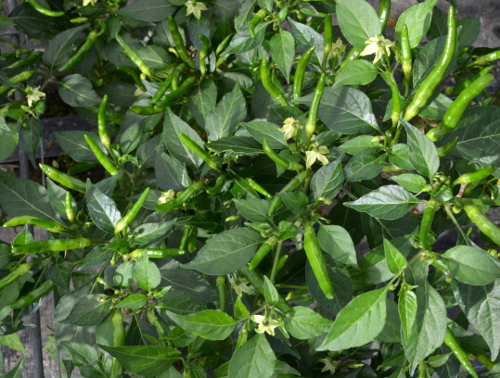
Capsicum lanceolatum plants still much smaller than any of the other species that I am growing, but opened first flower today.
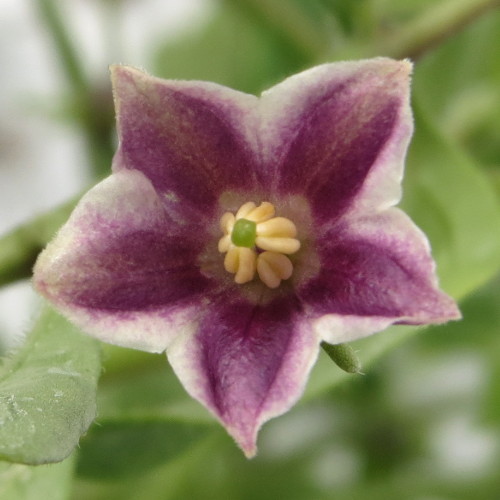
Two landraces of Capsicum annuum var glabriusculum both sown on 1st March: a dwarf Mexican chiltepin and a tall Guatamalan chiltepin.
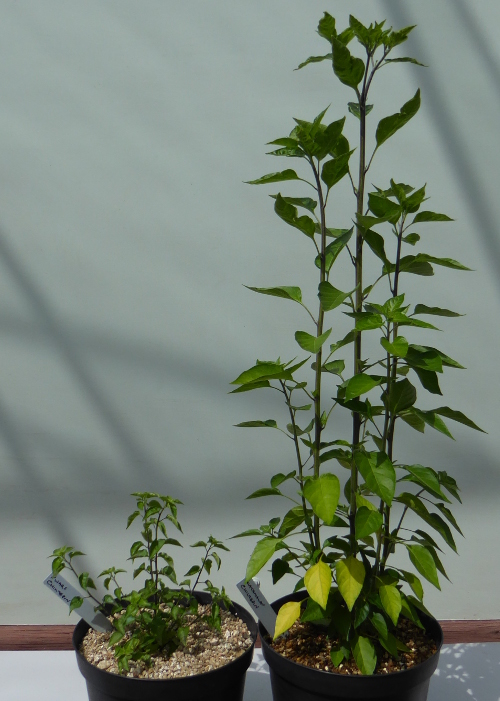
Now that the brief heat wave with glasshouse temperatures of 46°C has passed, it is interesting to look at its effect. All the cultivated chillies seemed to enjoy the extra heat, but the response of the wild species was more varied. Capsicum annuum var glabriusculum obviously enjoyed the conditions, as did C. galapagoense and C. chacoense. C. lanceolatum, however, scorched badly and looks in very poor condition; perhaps not surprising in that this accession originated in the Guatamalan cloud forest. Clearly this species likes high temperatures, but needs shade from strong sunlight and higher humidity than I was able to maintain. C. eximium is not looking as healthy as I would like, but in this case the cause is not so obvious.
Capsicum lanceolatum, which has looked rather delicate until now, has really enjoyed the recent very hot weather. Still in 9cm pots, but starting to grow more rapidly.
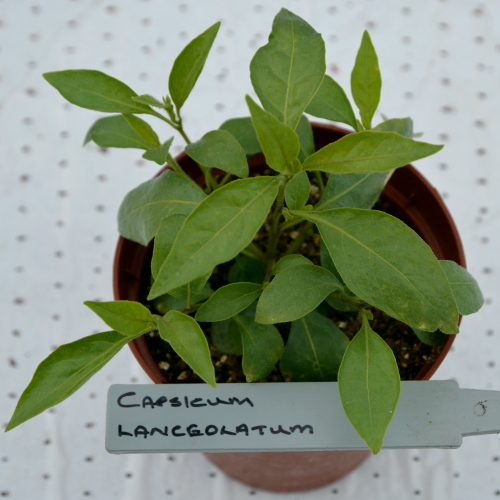
The most advanced Capsicum galapagoense seedlings were showing root out of the bottom of their 9cm pots, so decided to pot them up. Compared to the other species I am growing, root development was very weak with only a few thin unbranched roots on each plant. Will be more patient with the remainder!
First open chilli flower of the season, on overwintered Bolivian Rainbow. I am increasingly equivivocal about overwintering chilli plants as it creates an early season resevoir of pests and diseases, with aphids being the main problem at the moment.
Young Guatamalan Chiltepin, Capsicum annuum var. glabriusculum, in 13 cm pot.
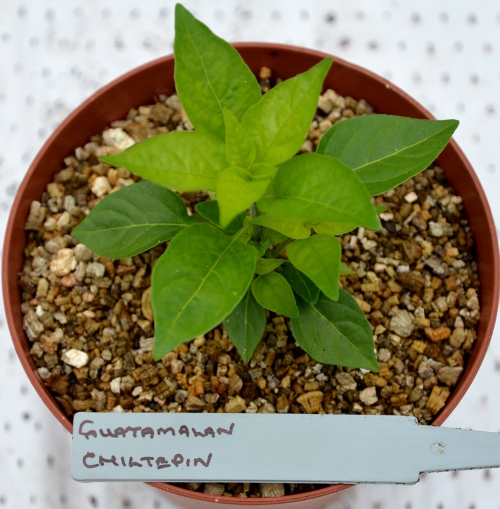
Chilli trial all planted in glasshouse, and a selection potted up into 13cm pots. All the Capsicum species are growing well, and developing their individual characters. Capsicum eximium, now in a 13cm pot, is noticeably pubescent.
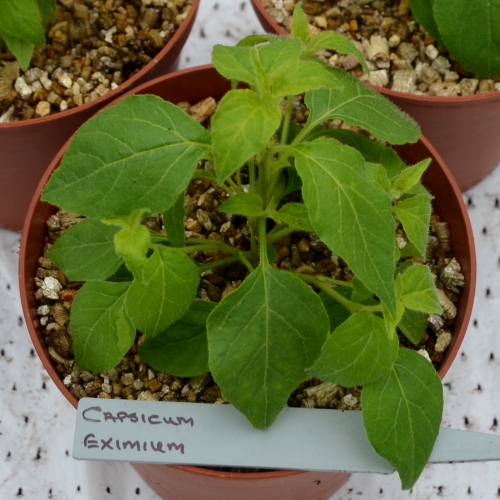
C. lanceolatum seedlings looking healthy, but unlike any other chilli seedlings.
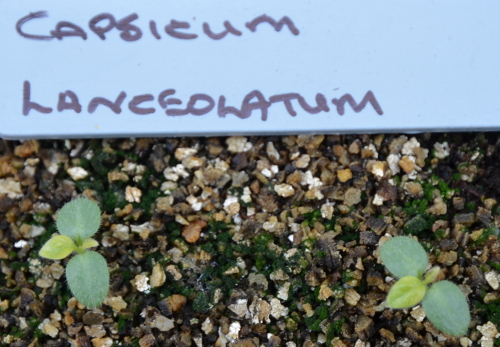
Germination of the wild Capsicum species has been better than expected. Germination was spread over 10 or 14 days, with the resulting seedlings being small and delicate, but the end result is definitely encouraging. C. lanceolatum was a worry as the first seedling to emerge was extremely small and looked quite unlike a chilli seedling, but now that germination has reached 60% they look very uniform and I am confident that I am not cultivating weed seedlings.
The more vigorous cultivars have now been moved up to 9cm pots, so progress should be quite rapid.
At last, only 15 days after sowing, the first Capsicum lanceolatum seedling has emerged. Now comes the real challenge - trying to raise the seedlings of the various species to maturity, and persuading them to produce ripe chillies for me to taste.
The first Capsicum galapagoense seeds germinated after 16 days which is a lot faster than expected. C. eximium, which was sown 10 days later than the main trial, started to germinate after only 11 days even though it is reputed to be very slow.
Germination of seed for the chilli variety trial has been fast and uniform this year. Only one variety still to emerge after 11 days, plus Capsicum galapagoense which is not part of the trial. Very pleased with the chilpetins, as I expect some good smoky flavours from them. Not enough is written about the flavour of many Capsicum species, so I will be growing and tasting as many as I can this season.
As the days grow brighter and warmer, it is becoming clearer which overwintered chilli plants have survived. Capsicum annuum and C. baccatum cultivars have fared best, along with C. chacoense which must surely be the easiest of all the wild species. C. chinense varieties have again proved the most tender and not one has survived.
If you choose the chilli varieties you grow for flavour rather than for compact growth, your plants are likely to need some support. I have now added a page with some ideas on how best to provide this support to ensure a long and fruitful season for your chillies.
Happy New Year to one and all.
Another year, another chilli trial in the offing. The focus this year will be on a Naga cross which produced some very interesting plants in the F2 generation. Mostly a bit too tall growing, but some really good flavours and unexpectedly sweet. I shall follow up two lines, one red fruited, the other brown; if I have enough space I may also include a more compact orange fruited line.
Back from a quick holiday in Spain on the Costa de Almeria. Food reasonable, but no chilli! I did not realise how much I would miss the flavour of the chillies that we use in everyday cooking. Will take a selection of chilli powders in my luggage next time.
A busy time photographing, harvesting and processing chillies. Still I have found time to add the first article on chilli cultivation which I hope will prove useful. More will follow over the winter months.
An exciting day tasting a hot chilli breeding line. First a piece without rib in order to get the flavour without the heat, then a piece with rib to get the full experience. It is interesting that the flavour is much fuller and more complex when the piece includes rib.
We have now been to see the chilli trials at both T & M and Fothergills. A lot of interesting material at both sites, some of which will be incorporated into our own trials program.
The flooding we experienced in June is still affecting crops. Our first picking of the sweet pepper Gargantua was by no means as sweet and tasty as it has been in other years. On a brighter note our breeding for a slow burn baccatum x frutescens cross is producing some fabulous chillies.
Jalapeño and Midas ripe. Fresh chillies taking over from chilli powders in our cooking.
We have the first ripe chillies on Zimbabwe Black, and some of our breeding lines have good looking ripe fruit. Quality testing starts soon.
Ripe chillies on an overwintered plant of Russian Yellow. My experience of overwintered plants is that they are not always earlier than spring sown ones, but this is significantly earlier than expected.
A difficult season, with very cold weather delaying planting in April followed by flooding in June. The hot spell in July caused further problems for plants which had suffered root damage in the flooding. Things are looking better now, but only two of our chillies, Chimayo and Havana Gold have ripe fruit so far.
Welcome to the new Chilli Guru website. The site already contains enough information to be interesting, but will continue to grow. This section will act as a mini blog charting the progress of my chilli plants through the year.
© 2016-22 The Chilli Guru™